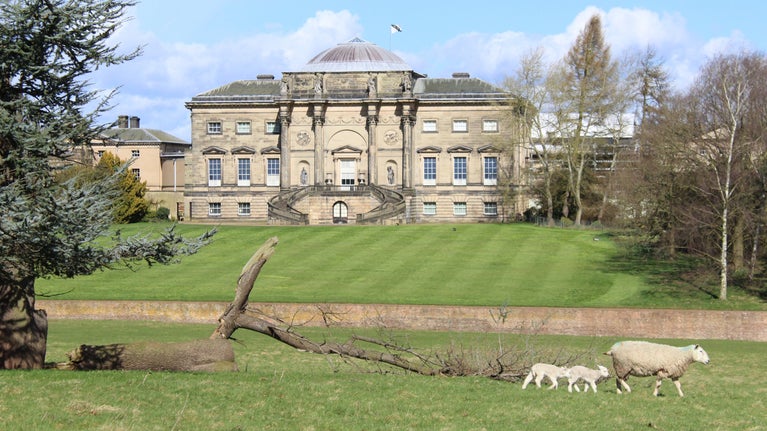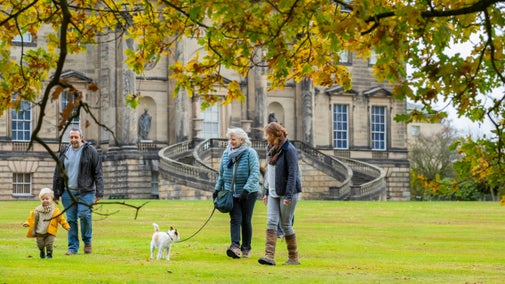
Discover more at Kedleston Hall
Find out when Kedleston Hall is open, how to get here, things to see and do and more.

Whether you're searching for wildlife, enjoying a short stroll or heading out on a heartier walk, Kedleston's 800 acres of parkland is ready to be explored. Here’s our guide to exploring the park at Kedleston, where you can take in views of the neoclassical Fishing Pavilion, look out for waterfowl and find wooden animal sculptures in the wilderness.
No swimming permitted on site.
This walk is a 1.7-mile circuit, which usually takes about 45–60 minutes. Amble along the first part of the Adam-inspired circuit walk to take in some of the park’s finest views. This route also takes you past the restored hermitage.
Although a portion of the route crosses back through the parkland, an alternative for those with wheelchairs or pushchairs is to visit the hermitage and then return back down the same path.
You'll spot benches along the way - an opportunity to give you a rest with a wonderful view.
Following storm damage, the Lakeside Walk is currently closed until further notice.
This is a longer route with a mixture of habitats along the way. Please be aware that the lakeside section of the path is not surfaced, so we recommend sturdy footwear, especially after wet weather.
This walk is a 3.2-mile circuit, which usually takes about 90 minutes and it's one of the best examples of an 18th-century circuit walk in the country. You’ll be able to retrace the footsteps of Kedleston's aristocratic visitors of the past and stop at the viewpoints that 18th-century visitors would have admired. There are benches along the route to take a rest and enjoy the views.
Currently closed following storm damage.
This walk is about two miles in length and usually takes around 60 minutes. It is fairly flat but across some uneven ground and there is a wooden footbridge and several gates along the route. This walk offers great views of the hall, weirs, neoclassical style Fishing Pavilion and Grade I listed Robert Adam bridge.
Amongst a rich diversity of wildlife in, on and around the lakes, listen out for oystercatchers calling in the spring and summer, and keep your eyes peeled for Little Egrets, Kingfishers and a host of other birds all year round. Find out more about our seasonal wildlife highlights on 'Visiting the Parkland.'
Explore the north side of the lake, known as the wilderness and find veteran oak trees (some are up to 1,000 years old) in the parkland beyond the lake on this walk. With great views of the Robert Adam bridge and the island, where numerous birds nest, you can also look out for the wooden animal sculptures hidden along the route. This walk includes uneven ground and passes through grazing cattle.
You'll find this area of the estate more wild and rugged in comparison to other areas, with fallen trees and long grass. This is all intentional, as a key conservation area of the parkland it provides habitats for all manner of animals from birds to woodland invertebrates.
Listen to our wilderness podcasts for more information about the animals you can find here and our management methods.

When spring’s dramatic birdsong quiets down and summer arrives, the full extent of Kedleston’s wildlife can be spotted across the parkland. Look out for buzzing bees, brown hares, birds, dragonflies and more.
Towards high summer, dragonflies and damselflies begin to appear around the lakes.
Spot broad-bodied chasers perching among the dock leaves on the Wilderness Walk (near the wooden bridge that you'll cross when walking round the lakes). You can see Emperor dragonflies flying over the lower lake and black-tailed skimmers perching at the edge of the middle lake.
The most common butterfly species in the parkland are meadow browns, which have small reddish marks on the wings with a single black dot in the middle. Spot them anywhere where the grass grows long. Look out for speckled woods in the sunny glades of the woodlands.
By summer, trees will be in full leaf, shading out the woodland floor below them. Look for the distinctive leaves of the oak tree. If you find any lime trees in flower, they will be buzzing with bees. Some may even be lying on their backs on the ground having had their fill.

As the breeding season ends, birdlife can be quiet in the heat of summer but be sure to look for the brilliant mud nests the house martins make on the front of the Hall. These birds swoop about like swallows and are distinctive for their white rumps.
On the lakes, look out for swans and their cygnets and by the bridge and weirs, for grey wagtails. The black and white pied wagtails can often be seen in front of the hall, sometimes with their young.
There have been sightings of roe deer. You may also spot muntjac deer, though they are typically only active after dark and being small can easily be mistaken for a dog.
Brown hares seem to have increased with several sightings of half-grown leverets. Kedleston parkland also has a good complement of bats.
We welcome dogs, but we do ask that they are kept on a lead at all times due to grazing sheep and cows, and wildlife sensitive to disturbance.
To find out about the dog policy here at Kedleston along with facilities available, take a look at our visiting with your dog guide.
Why not take photos on your walk? Share with us online by tagging us on social media #KedlestonHall
Cameras are always welcome, but the use of drones is not permitted anywhere at Kedleston, for the safety of our visitors, buildings and livestock.
Our walking map is available in English, Urdu and in Punjabi. Please refer to our access statement for full access details around the site.

Find out when Kedleston Hall is open, how to get here, things to see and do and more.

We’ve partnered with Cotswold Outdoor to help everyone make the most of their time outdoors in the places we care for.
Kedleston is a two pawprint rated place. Well-behaved dogs on leads are welcome throughout the gardens and parkland, with great walks for you both to enjoy.

Visit the Hall at Kedleston, which is a prime example of 18th-century Palladian and Neoclassical inspired architecture and the ancestral residence of the Curzon family.

Discover more about Kedleston’s vibrant story and how it’s entangled with global histories, from Rome to India.
